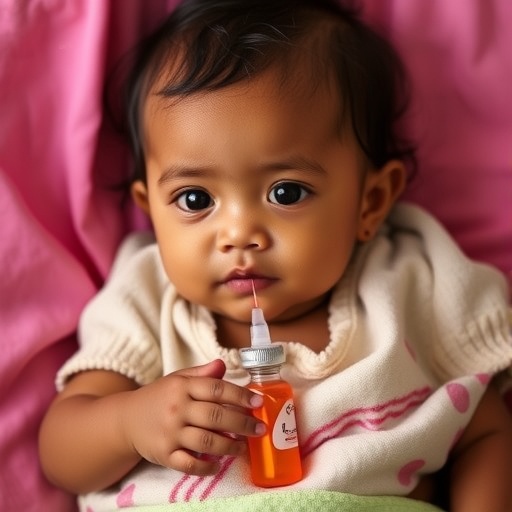A groundbreaking study recently published in Nature reveals the promising potential of a single gene therapy injection administered at birth to provide durable protection against HIV infection, potentially changing the landscape of pediatric HIV prevention in regions most vulnerable to the virus. This innovative approach exploits the unique immunological window present in early life—a period when the infant immune system is more tolerant and less prone to rejecting foreign genetic material. By harnessing this critical developmental stage, the therapy could circumvent one of the longstanding challenges in gene-based interventions: immune rejection.
The investigation, led by Amir Ardeshir at the Tulane National Primate Research Center in collaboration with colleagues from the California National Primate Research Center, focused on delivering gene therapy to nonhuman primates during the neonatal period. Researchers utilized an adeno-associated virus (AAV) vector, a non-pathogenic viral vehicle known for its stable transduction capabilities and minimal immunogenicity, to insert genetic sequences encoding broadly neutralizing antibodies (bNAbs) against HIV. These antibodies have the ability to recognize and neutralize diverse HIV strains, overcoming the virus’s notorious capacity for mutation and escape.
Central to the study’s findings was the timing of the intervention. When administered within the first month of life, the gene therapy effectively programmed muscle cells—chosen for their longevity and stability—to continuously produce HIV-specific bNAbs. This “one-and-done” treatment resulted in sustained antibody expression, providing over three years of protection against HIV exposure, recapitulating critical periods of vulnerability from infancy through adolescence in humans. By contrast, subjects treated after the neonatal period developed anti-drug antibodies that limited the effectiveness of the therapy, underscoring the immune system’s maturation as a barrier to gene therapeutic strategies at later stages.
This perpetual antibody production offers a compelling solution to the practical challenges associated with passive immunization strategies. Prior studies demonstrated that bNAbs delivered through repeated infusions could suppress HIV infection, yet the necessity for regular administration imposes high costs and significant logistical burdens, particularly in low-resource settings where the epidemic is most severe. The ability to induce endogenous, sustained antibody generation circumvents these limitations, potentially enabling widespread, cost-effective prophylaxis without dependence on continuous healthcare access.
The study also illuminated the immunological mechanisms underlying early-life tolerance to gene therapy. Neonatal immune systems are characterized by a heightened capacity to accept foreign proteins and genetic material without mounting robust immune responses. This tolerance enables the muscle cells transduced by the AAV vector to function as long-lived biofactories, continuously secreting potent bNAbs without triggering neutralizing immune reactions that would deactivate the treatment. Interestingly, exposure to these antibodies in utero further enhanced older infants’ acceptance of the therapy post-birth, suggesting prenatal interventions could augment treatment efficacy.
From a public health perspective, these findings hold immense promise for high-risk populations, especially in sub-Saharan Africa where mother-to-child transmission remains a significant vector of pediatric HIV infection. With an estimated 300 children newly infected daily—primarily through breastfeeding post-delivery—there is an urgent need for interventions that provide robust protection during this vulnerable period. Conventional antiretroviral therapies (ART) have improved outcomes but face challenges with adherence and continuity of care postpartum. The gene therapy’s single-administration model aligns well with existing healthcare delivery patterns, providing a practical tool to shield infants during their most susceptible stages.
Technically, the researchers harnessed the stability of muscle tissue to act as a durable reservoir for bNAb production. AAV vectors target muscle cells efficiently due to their accessibility and resilience, enabling long-term transgene expression with minimal off-target effects. Unlike other viral vectors, AAVs do not integrate into the host genome but persist episomally, minimizing insertional mutagenesis risk while achieving prolonged therapeutic gene expression. This delivery strategy balances efficacy and safety, crucial considerations for translation to human applications.
Despite these encouraging results, certain limitations temper immediate clinical translation. The research employed a single simian–human immunodeficiency virus (SHIV) strain, which, while appropriate for proof-of-concept, does not encompass the full genetic diversity of HIV strains circulating in human populations. Moreover, human infants’ immunological responses to AAV vectors may differ, potentially affecting transduction efficiency and durability. Further studies are necessary to optimize vector design, dosage, and timing, as well as to evaluate efficacy across a broader spectrum of viral variants.
Looking beyond HIV, the study opens avenues for utilizing early-life gene therapy to combat other infectious diseases disproportionately affecting children in low-income regions, such as malaria. The strategy of converting muscle cells into continuous producers of protective antibodies or other therapeutic proteins could revolutionize preventive medicine and address critical health disparities.
Amir Ardeshir emphasized the transformative nature of these findings, highlighting the convergence of immunology, virology, and gene therapy that was once deemed unattainable. The capacity to reprogram the immune system during its naivete offers a fundamentally new paradigm in the fight against HIV, shifting from reactive treatments to proactive, long-lasting protection conferred at birth.
Supported by an array of prominent funders including the National Institutes of Health and the Bill and Melinda Gates Foundation, this research exemplifies the power of collaborative science and innovative therapeutic design to tackle some of the world’s most pressing health challenges. As the field moves toward clinical trials, the prospect of a long-lasting, one-time treatment for pediatric HIV prevention becomes an increasingly tangible reality, with profound implications for global health.
Subject of Research: Animals
Article Title: Determinants of successful AAV-vectored delivery of HIV-1 bNAbs in early life
News Publication Date: 30-Jul-2025
Web References: http://dx.doi.org/10.1038/s41586-025-09330-2
Keywords: HIV prevention; Preventive medicine; Gene therapy; Gene delivery; Broadly neutralizing antibodies; Viral infections; Immunology; Antibody therapy; Pediatric HIV; Adeno-associated virus; Breastfeeding; Immunotherapy




